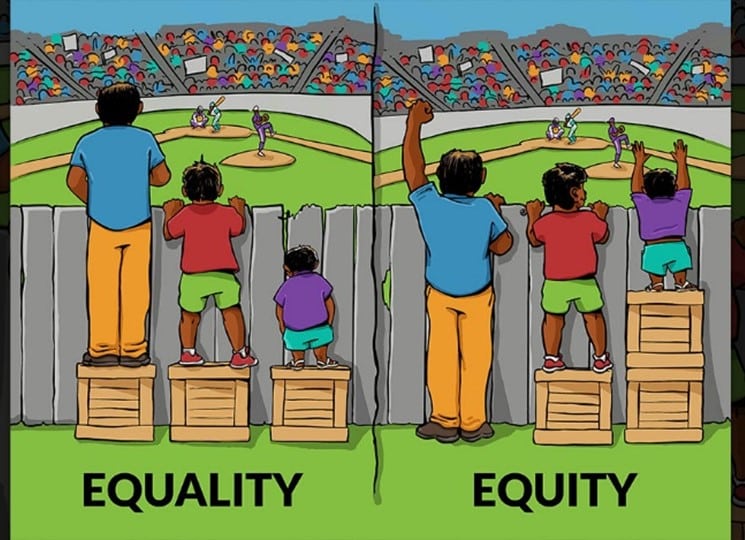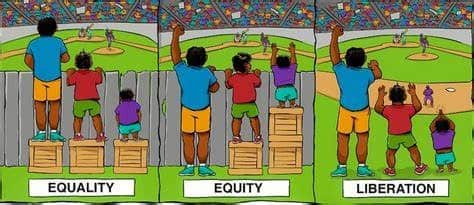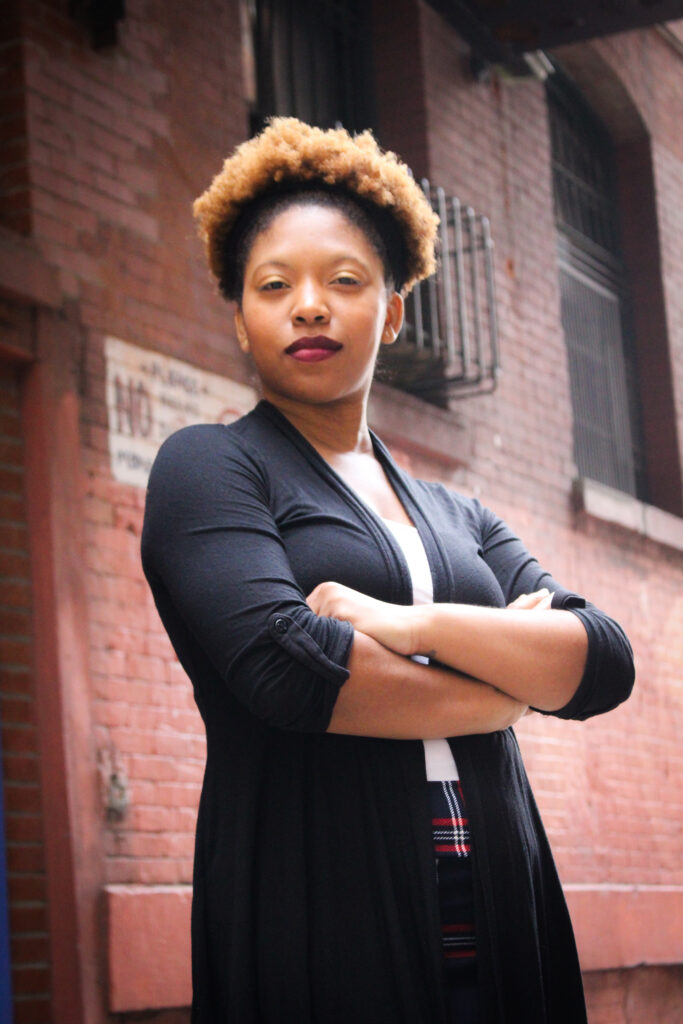Sermon Seeds: Withering Grace…Standing Word
Sunday, December 10, 2023
Second Sunday of Advent | Year B
(Liturgical Color: Purple)
Lectionary Citations
Isaiah 40:1-11 • Psalm 85:1-2, 8-13 • 2 Peter 3:8-15a • Mark 1:1-8
Focus Scripture: Isaiah 40:1-11
Focus Theme: Withering Grace…Standing Word
Series: Tear Open the Heavens (Click here for the series overview.)
Reflection
By Mia McClain

Image description: This is a side-by-side depiction of “Equality” vs. “Equity. In the image on the left: 3 people of different heights are standing on brown boxes situated on green grass and looking over a grey fence onto a baseball field. The 3 people are standing on boxes of the same height. The tallest person can clearly see. The middle height person can see enough. The shorter person can’t see at all. This is equality, the image suggests. In the image on the right: the tallest person has given their box to the shortest person. The tallest person can still see the field without a box. Nothing has changed for the middle height person. The shortest person now has two boxes to stand on and can see the game. This is equity, the image suggests.
Two Park Avenues
Many of you might be familiar with this image. I remember seeing this for the first time and so many things beginning to make sense for me. I was living in New York City, a place where one is no stranger to economic disparity (even if one tries to pretend like it’s not among them). “There are two Park Avenues,” the people told me when I arrived in 2011. I worked at a restaurant in the Upper East Side near the wealthy Park Avenue—the section lined with multimillion dollar condominiums that rarely go on sale. Old Money. Revitalized stone exteriors and marble interiors that hold the secrets of exploitation. The many b/millionaires that call this Park Avenue home have personal drivers. They do not have to endure the stench of the aging subway system that now floods with every heavy rain. At the end of a double shift, I’d often hop a taxi uptown. As the street numbers got higher, the luxuriousness dropped. By the time we crossed 96th Street, it was—as the 80s sitcom theme song said—“a different world than where you come from.” The other Park Avenue was a different world, no less exciting or enthralling.
Most people on my end of Park Avenue did not frequent the other end often. The same could be said for the residents of the doorman-dwelling luxury dens who would have no business—no reason to go—uptown. While many of my friends who called Northern Manhattan and the Bronx home in our 20s did alright making a dollar out of 15 cents, we had neighbors in far more precious economic situations.
- What could our existences have been like if every valley had been lifted and every mountain and hill made low?
- What kind of dreaming and creating could we have done if the uneven ground had become level?
- Who could my neighbors have been if they weren’t working 14 hours shifts, enduring 75-minute commutes each way, and doing all of this to not even see over the fence?
- §What magic died within them because the tallest person refused to give their box to the shortest among them?
I do not mean to oversimplify the issue of equity, and yet as I am sitting with Isaiah 40:4, I can’t help but think about the multiple benefits a level playing field would have had—could still have.
Edouard Kitoko Nsiku gives insight into 2nd Isaiah’s prolific pronouncement. “Apart from a few messianic asides…the prophet Isaiah has [up to this point] been interested in Israel and Judah over the short term. …Now he turns to more long-term prophecies, which will be fulfilled after his death.” (Nsiku, Africa Bible Commentary) Thus, Isaiah knows that he will not see all the fruits of his labor in his lifetime—that God’s justice is not going to be a quick fix or take a microwaveable approach. This “good news” becomes hard news for many of us who are acquainted with modern consumerist modalities—fast food, fast service, next-day delivery, same-day delivery, door dash. This passage comes to a people who can’t see over the fence, who haven’t been able to see over the fence for several generations, yet who still have a hope that one day the lowly will be lifted.
Nsiku goes on to describe the exiles hearing a herald’s voice (Isa 40:3) commanding that a highway be built in the desert. “The desert,” Nsiku says, “often symbolized divine punishment and desolation, but paradoxically it has also been a place of discovering God or returning to God.” In this desert, a way would be made; God would show Godself in the unexpected place. This way in the rough, unexpected place “will be a smooth road, with no obstructions,” for every valley will be lifted and every hill be brought down (Nsiku); But the geographical renovations are not merely about easy access for a messianic figure to come through and rescue; these terrestrial reconstructions also symbolize the equity of God coming into being. Perhaps, they can be likened to a shifting of the boxes upon which the 3 people are standing. Rewritten in this context, Isaiah 40:4 might say, “every shorter person who desires a box to stand on shall get one, and every taller person who doesn’t need a box to stand on shall give their box away.” This seems like a simple redistribution of resources; yet most societies throughout history have struggled to bring this to fruition.
But is this enough? Is a leveling of the playing field what’s really being called for?
Preparing the Way
The Gospel According to Mark opens quoting Malachi 3 and slides into Isaiah 40. A professor of Judaic Studies, Lawrence M. Wills, deals with Marks use of these combined texts:
“Mark may have known these texts from “testimonia,” collections of verses on a common theme: in this case, on God’s way. “Way” is a technical term in Greek, Jewish, and Christian ethical discourse on choosing the good, albeit difficult, path as opposed to the immoral, easy path.” (Lawrence M. Wills, Jewish Annotated New Testament)
Wills offers that the word “way” in Greek is comparable to the Jewish notion of “halakah,” how one walks. The way, then, is not the path, itself, but how we move toward a path. It is (a) movement. I want to take it a step further and suggest that preparing the way is preparing the renegotiation and transformation of the conditions of our living together in a way that calls forth liberation.
Thus, we are not waiting for a person, per se, to walk through; we are creating a movement through and toward liberation. This movement does not stop at equality; that is not enough. Rabbi Danya Ruttenberg reflects on the equality image saying, “everyone having the same support is not enough because the system for keeping people out impacts different people in different ways.” Moreover, the movement cannot settle for equity. In an equitable reality, everyone has the support they need–the boxes they need or don’t need—to maneuver through the system; but what we call into question if this system full of barriers is one that even needs to exist? The call to prepare the way is a movement toward challenging the necessity for systems that wear us out with barriers. It is a calling out of the systems that keep many in cycles of poverty. It is asking, “why do we have this fence here in the first place?” “Why do we have these barriers to affordable health care in the first place? Why are people hungry in the most wasteful country in the world? What Rabbi Ruttenberg suggests of the liberation image, below, is that “instead of making the system more accessible to everybody, they’re dismantling the system entirely.” They are creating a new way in the unexpected place—a collective movement in the desert.

Image description: This is a side-by-side depiction of “Equality” vs. “Equity” vs. “Liberation” from left to right. In the image on the left: 3 people of different heights are standing on brown boxes situated on green grass and looking over a grey fence onto a baseball field. The 3 people are standing on boxes of the same height. The tallest person can clearly see. The middle height person can see enough. The shortest person can’t see at all. This is equality, the image suggests. In the middle image: the tallest person has given their box to the shortest person. The tallest person can still see the field without a box. Nothing has changed for the middle height person. The shortest person now has two boxes to stand on and can see the game. This is equity, the image suggests. In the image on the right: There are no boxes because there is no fence. The barrier has been removed and now all 3 people can freely see the baseball field. This is liberation, the image suggests.
A Collective Memory of the Hope of Liberation
I will not pretend like I was well acquainted with the ideas of equity and liberation back in my early 20s. I certainly couldn’t have quoted Isaiah 40, although I was a regular church goer. Yet, I have to believe that part of what got me out of bed most mornings was a faint recollection of this promise rendered through the voice of Second Isaiah—that every valley would be raised up. I have to believe that part of what kept many of us going was the hope of the Magnificat (Luke 1:52)—that the lowly would be lifted. What helped me stay the course amidst precarious housing challenges, financial uncertainty, food stamps, and unemployment was an ancestral memory in my bones that I likely couldn’t articulate at that time, yet my body knew it. We hold the hopes of liberation deep in the memory. It is a memory of the promise of a way in the wilderness—a memory of a movement toward dismantling systems, asking hard questions, and tearing down barriers that keep us in cycles of marginalization. That memory sustains us. It is a collective memory, for our individual memories do not always hold up due to a myriad of circumstances. Where I forget, I hope that you’ll remember; and where you forget, I hope that someone in the community will remember. The practice of Advent, including the recitation and interrogation of sacred texts, in a practice of remembering liberation together.
Reflection from Voices of People of African Descent
The 33rd General Synod adopted a Resolution to Recognize the United Nations International Decade for People of African Descent (2015-2024). As part of its implementation, Sermon and Weekly Seeds offers Reflection from Voices of People of African Descent related to the season or overall theme for additional consideration in sermon preparation and for individual and congregational study.
“Sometimes people hold a core belief that is very strong. When they are
presented with evidence that works against that belief, the new
evidence cannot be accepted. It would create a feeling that is
extremely uncomfortable, called cognitive dissonance. And because it
is so important to protect the core belief, they will rationalize,
ignore and even deny anything that doesn’t fit in with the core belief.”
― Frantz Fanon, Black Skin, White Masks
For Further Reflection
“Looking at the past must only be a means of understanding more clearly what and who they are so that they can more wisely build the future.” ― Paulo Freire
“People get used to anything. The less you think about your oppression, the more your tolerance for it grows. After a while, people just think oppression is the normal state of things. But to become free, you have to be acutely aware of being a slave.” ― Assata Shakur
“Real liberation comes not from glossing over or repressing painful states of feeling, but only from experiencing them to the full.” ― C.G. Jung
Works Cited
Chesed, Tzedakah, Tzedek: What’s the Difference? – YouTube Ft. Rabbi Danya Ruttenberg
https://www.youtube.com/watch?v=KUkEDWMbTkQ&t=6s
BimBam sparks connections to Judaism through digital storytelling for learners of all ages. Founded in 2008, BimBam’s catalog of hundreds of animated videos and other digital content are now under the auspices of the Union for Reform Judaism, and many can be found on its flagship educational website, ReformJudaism.org.
Adeyemo, Tokunboh, and Edouard Kitoko Nsiku. “Isaiah.” Africa Bible Commentary,
HippoBooks, Carlisle, 2016, pp. 835–878.
Wills, Lawrence M., Levine, Amy-Jill, et al. “The Gospel According to Mark.” The Jewish Annotated New Testament: New Revised Standard Version Bible Translation, Oxford University Press, Oxford, 2017, pp. 67–106.
Suggested Congregational Response to the Reflection
During the Advent Season, invite the congregation to respond (with a word of two shared in the gathered community, comments/chat shared in online platforms, or by journalling) to the question, “What do you discern the Holy Spirit still speaking about hope/peace/joy/love today?”
Worship Ways Liturgical Resources
https://www.ucc.org/worship-way/advent-2b-december-10/

The Rev. Mia M. McClain is the Senior Pastor of Riverside Baptist Church in Washington D.C. She is an ordained UCC minister.
The Rev. Dr. Cheryl A. Lindsay, Minister for Worship and Theology (lindsayc@ucc.org), also serves a local church pastor, public theologian, and worship scholar-practitioner with a particular interest in the proclamation of the word in gathered communities. You’re invited to share your reflections on this text in the comments on our Facebook page: https://www.facebook.com/SermonSeeds.
A Bible study version of this reflection is at Weekly Seeds.
Lectionary Texts
Isaiah 40:1-11 • Psalm 85:1-2, 8-13 • 2 Peter 3:8-15a • Mark 1:1-8
Find the full text here: https://lectionary.library.vanderbilt.edu/texts.php?id=49